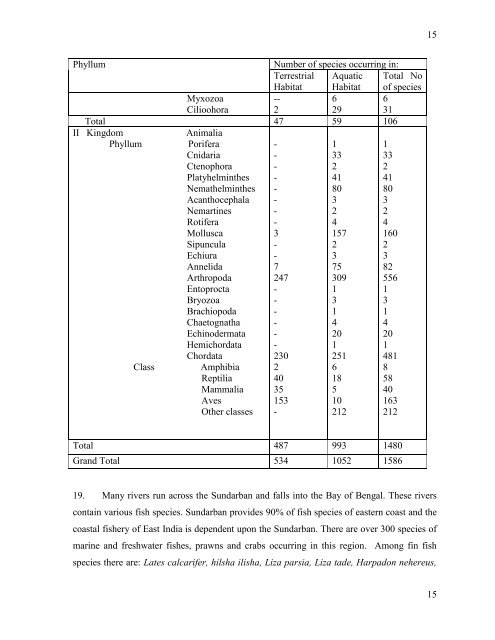integrated coastal zone management project west ... - Iczmpwb.org
integrated coastal zone management project west ... - Iczmpwb.org integrated coastal zone management project west ... - Iczmpwb.org
15PhyllumNumber of species occurring in:TerrestrialHabitatAquaticHabitatTotal Noof speciesMyxozoaCilioohora--2629631Total 47 59 106II KingdomAnimaliaPhyllum PoriferaCnidariaCtenophoraPlatyhelminthesNemathelminthesAcanthocephalaNemartinesRotiferaMolluscaSipunculaEchiuraAnnelidaArthropodaEntoproctaBryozoaBrachiopodaChaetognathaEchinodermataHemichordataChordata--------3--7247------23013324180324157237530913142012511332418032416023825561314201481Class AmphibiaReptiliaMammaliaAvesOther classes24035153-61851021285840163212Total 487 993 1480Grand Total 534 1052 158619. Many rivers run across the Sundarban and falls into the Bay of Bengal. These riverscontain various fish species. Sundarban provides 90% of fish species of eastern coast and thecoastal fishery of East India is dependent upon the Sundarban. There are over 300 species ofmarine and freshwater fishes, prawns and crabs occurring in this region. Among fin fishspecies there are: Lates calcarifer, hilsha ilisha, Liza parsia, Liza tade, Harpadon nehereus,15
16Plotosus canius, Pompus argenteus, Pangasius pangasius, Chanos chanos, Eleutheronematetradactylum, Polynemous paradiseus and Pama pama. Shellfish species includes Penaeusmonodon and Metapenaeus monoceros. There are two types of edible crabs: Scylla serrataand neptunus pelagiens. Among these, the most highly valued economic species is the Tigerprawn (Penaeus monodon). In fact, major economic activities of this region centre round thisspecies through collecting and marketing seeds as well as rearing and farming in brackishwater bheries. Amongst the fin fishes, the highly priced hilsa (Teualosa ilisha), bhetki (Latescalcarifer), bhangone (Liza tade), parse (Liza parsia), etc., form a lucrative fishery of thisregion. More than 500 tonnes of the mud crab (Scylla serrata) is exported alive to far easterncountries. Indiscriminate exploitation of fishery resources and unregulated use of shootingnets of small mesh size in the estuary for the collection of tiger prawns (Penaeus monodon)seeds are resulting in tremendous loss of diversity of faunal components in the estuaries ofSBR. The result of such rampant destruction of other juvenile fish seeds has been reflected inthe drop in availability and catch of other fish species in the estuaries. The estimated numberof fish species lost by this process is about 30 in number which are of indigenous type. Thesespecies breed naturally in the estuaries and cannot be breed in captivity. The loss inbiodiversity has also been evident by species wise drop in fish catch by the fishermen.20. The annual total fish yield (in metric ton) in Sundarban varies from about 26000 to51000 with about 80% of the fish catch taking place during November to January. Out of thetotal annual catch, the annual Hilsha Drift Gillnet Fishery yields about 1000 to 7500 tons.21. The land is inhabited by Royal Bengal Tigers. Wildlife of Sunderbans also harboursjungle cats, fishing cats, Axis deer, wild boar, Rhesus monkeys, mongooses and the largestestuarine crocodiles in the world. Sunderbans is the breeding ground of immense variety ofbirds like Heron, Egret, Cormorant, Fishing Eagle, White Bellied Sea Eagle, Seagul, Tern,Kingfisher as well as migratory birds like Whimprel, Black-tailed Godwit, Little Stint,Eastern Knot, Curlew, Sandpiper, Golden Plover, Pintail, White-eyed Pochard and alsoWhistling teal. Wide variety of aquatic and reptile life forms are present that include OliveRidley sea turtle, hardshelled Batgur Terrapin, Pythons, King cobra, Chequered killback,Monitor and lizards including the Salvator lizards. The Sundarban ecosystem is characterisedby a very dynamic environment due to the effect of tide, flooding, salinity and cyclones. As aresult several remarkable species are found such as estuarine crocodile (Crocodilus porosus),16
- Page 1 and 2: INTEGRATED COASTALZONE MANAGEMENTPR
- Page 3: 2INTEGRATED COASTAL ZONE MANAGEMENT
- Page 9 and 10: 84. Agriculture is the major occupa
- Page 11 and 12: 10volume of sediment carried by the
- Page 13 and 14: 12small estuary to the east is Jald
- Page 15: 14Biosphere Reserve by UNESCO in 20
- Page 19 and 20: 18huge Ganges catchment. Pollution
- Page 21 and 22: 20Bengal. The port handles over 28
- Page 23 and 24: 2240. The Act is one of the major e
- Page 25 and 26: 24norms. The area up to 200 metres
- Page 27 and 28: 261. No construction to be permitte
- Page 29 and 30: 28survey of flora, fauna, forests a
- Page 31 and 32: 30so far. The major research areas
- Page 33 and 34: 32connected with the Bengal Smoke N
- Page 35 and 36: 34Authority has been given wide ran
- Page 37 and 38: 36technical field staff in biodiver
- Page 39 and 40: 38In RupeesDepartment of GOWBYear20
- Page 41 and 42: 144some sources of residual oil, gr
- Page 43 and 44: 146111. The east coast of India is
- Page 45 and 46: 148Dredging in and around Haldia po
- Page 47 and 48: 150market forces. The average econo
- Page 49 and 50: 152131. The outcome of the importan
- Page 51 and 52: 154STRENGTH WEAKNESS OPPORTUNITIES
- Page 53 and 54: 156B. Project Objectives and Key In
- Page 55 and 56: 158continue to earn their livelihoo
- Page 57 and 58: 160Component A.1 - Prevention of co
- Page 59 and 60: 162meander scrolls, now abandoned,
- Page 61 and 62: 164carried down to Sagar Island by
- Page 63 and 64: 166Dublat the formation of a spit,
- Page 65 and 66: 16827.33 crores having a works cost
15PhyllumNumber of species occurring in:TerrestrialHabitatAquaticHabitatTotal Noof speciesMyxozoaCilioohora--2629631Total 47 59 106II KingdomAnimaliaPhyllum PoriferaCnidariaCtenophoraPlatyhelminthesNemathelminthesAcanthocephalaNemartinesRotiferaMolluscaSipunculaEchiuraAnnelidaArthropodaEntoproctaBryozoaBrachiopodaChaetognathaEchinodermataHemichordataChordata--------3--7247------23013324180324157237530913142012511332418032416023825561314201481Class AmphibiaReptiliaMammaliaAvesOther classes24035153-61851021285840163212Total 487 993 1480Grand Total 534 1052 158619. Many rivers run across the Sundarban and falls into the Bay of Bengal. These riverscontain various fish species. Sundarban provides 90% of fish species of eastern coast and the<strong>coastal</strong> fishery of East India is dependent upon the Sundarban. There are over 300 species ofmarine and freshwater fishes, prawns and crabs occurring in this region. Among fin fishspecies there are: Lates calcarifer, hilsha ilisha, Liza parsia, Liza tade, Harpadon nehereus,15



